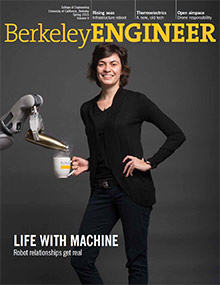Dean’s word: The future of intelligence
Machine intelligence and robotics have made giant progress recently — with automated cars, flying machines and robotic manufacturing on the front pages of the popular press, seemingly every week. To learn more about the Deep Learning technology behind these artificial intelligence (A.I.) advances, Rolling Stone and the Atlantic came to some of Berkeley’s most outstanding young roboticists, introducing readers to Pieter Abbeel’s “robot nursery school,” where robots learn as children do, by hand and by sight, and Anca Dragan’s well-mannered autonomous vehicles, which back up politely to signal yielding to others at an intersection.
With Deep Learning technology, A.I. is making a huge leap forward.
Designed to mimic the human brain’s neural network, Deep Learning builds on research pioneered here at Berkeley in the 1980s. With the advent of massive computing power, it is now possible to bring such advanced machine learning to a number of new domains, including driving, computer vision and robotics.
At a Dean’s Society event last December, a panel of A.I. researchers discussed the breadth of the work at the college. Cortera Neurotechnologies co-founder and new EECS faculty member Rikky Muller discussed how brain-machine interfaces can help people with neurological differences lead fuller lives. IEOR professor Ken Goldberg, who leads the CITRIS People and Robots Initiative, discussed advances in robotic surgery with alumnus Gary Guthart, CEO of Intuitive Surgical, makers of the minimally invasive da Vinci Surgical System. Computer science professor Stuart Russell, who co-wrote the seminal A.I. textbook with alum and fellow panelist Peter Norvig of Google, spoke about the evolution of machine intelligence and the need to build fundamental human values into machine learning. Stuart, who taught a class on that subject this past term, is also leading an international campaign to require safeguards in lethal autonomous weapons systems.

Deans’ words: Dean Sastry joined Georgia Tech Engineering Dean Gary May and students before the 2016 Kuh Distinguished Lecture; watch Dean May’s talk on broadening STEM participation.
We face important questions about how robots will work with humans, how machine learning and A.I. can be integrated into societal systems and indeed, the workplace of the future. As part of our mission to serve society, we are well-poised at Berkeley to assess the potential complications associated with augmenting human cognitive capabilities, while at the same time addressing the economic, legal and social consequences of this emerging technology.
As always, I welcome your thoughts and ideas.
—S. Shankar Sastry
Dean and Roy W. Carlson Professor of Engineering
Director, Blum Center for Developing Economies

